Non-Kekulé molecule
A non-Kekulé molecule is a conjugated hydrocarbon that cannot be assigned a classical Kekulé structure.

Since non-Kekulé molecules have two or more formal charges radical centers, their spin-spin interactions can cause electrical conductivity or ferromagnetism (molecule-based magnets), and applications to functional materials are expected. However, as these molecules are quite reactive and most of them are easily decomposed or polymerized at room temperature, strategies for stabilization are needed for their practical use. Synthesis and observation of these reactive molecules are generally accomplished by matrix-isolation methods.
Biradicals
The simplest non-Kekulé molecules are biradicals. A biradical is an even-electron chemical compound with two free radical centres which act independently of each other. They should not be confused with the more general class of diradicals.[1]
One of the first biradicals was synthesized by Wilhelm Schlenk in 1915 following the same methodology as Moses Gomberg's triphenylmethyl radical. The so-called Schlenk-Brauns hydrocarbons are:[2]

Eugene Müller, with the aid of a Gouy balance, established for the first time that these compounds are paramagnetic with a triplet ground state.
Another classic biradical was synthesised by Aleksei Chichibabin in 1907.[3][4] Other classical examples are the biradicals described by Yang in 1960[5] and by Coppinger in 1962.[6][7][8]
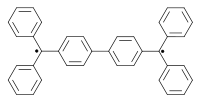 |
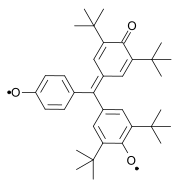 | 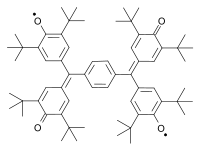 | ||
| Tschitschibabin biradical (1907) | Yang biradical (1960) | Coppinger biradical 1962 | ||
Trimethylenemethane
A well studied biradical is trimethylenemethane (TMM), C
4H
6. In 1966 Paul Dowd determined with electron spin resonance that this compound also has a triplet state. In a crystalline host the 6 hydrogen atoms in TMM are identical.
Quinodimethanes and PAHs
Other examples of non-Kekulé molecules are the biradicaloid quinodimethanes, that have a six-membered ring with methylene substituents.
Non-Kekulé polynuclear aromatic hydrocarbons are composed of several fused six-membered rings. The simplest member of this class is triangulene. After unsuccessful attempts by Erich Clar in 1953, trioxytriangulene was synthesized by Richard J. Bushby in 1995, and kinetically stabilized triangulene by Kazuhiro Nakasuji in 2001. However, in 2017 a project led by David Fox and Anish Mistry from the University of Warwick in collaboration with IBM synthesized and imaged triangulene.[9] The larger homologue π-extended triangulene, consisting of ten fused six-membered rings with a spin quartet ground state, was synthesized in 2019.[10] A related class of biradicals are para-benzynes.
Other studied biradicals are those based on pleiadene,[11] extended viologens,[12][13] corannulenes,[14] nitronyl-nitroxide,[15] bis(phenalenyl)s [16] and teranthenes.[17][18]
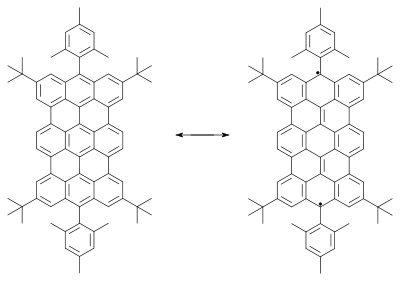 |
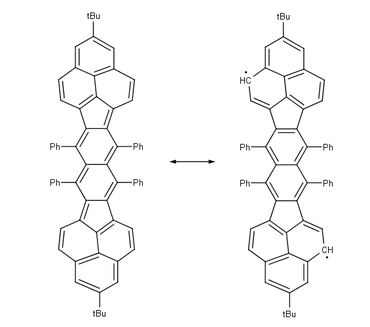 | |
| Teranthene biradical Singlet. max. 3 stabilizing Clar sextets, stable rt, air. 50% biradical, molecular section of graphene | Bisphenalenyl biradical Singlet. max. 6 stabilizing Clar sextets, stable rt, air. 42% biradical | |
Pleiadene has been synthesised from acenaphthylene and anthranilic acid / amyl nitrite:
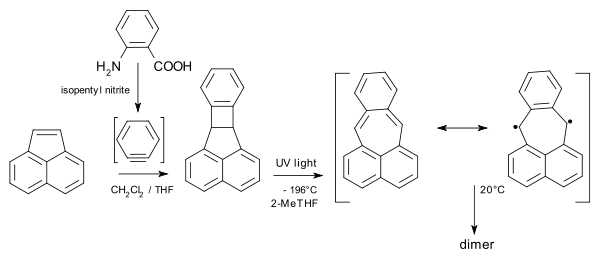 |
| Pleiadene generation and dimerization |
Oxyallyl
The oxyallyl diradical (OXA) is a trimethylenemethane molecule with one methylene group replaced by oxygen. This reactive intermediate is postulated to occur in ring opening of cyclopropanones, allene oxides and in the Favorskii rearrangement. The intermediate has been produced by reaction of oxygen radical anions with acetone and studied by photoelectron spectroscopy.[19] The experimental electron affinity of OXA is 1.94 eV.
Classification
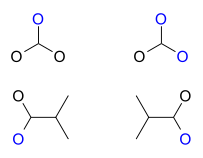
Non-Kekulé molecules with two formal radical centers (non-Kekulé diradicals) can be classified into non-disjoint and disjoint by the shape of their two non-bonding molecular orbitals (NBMOs).
Both NBMOs of molecules with non-disjoint characteristics such as trimethylenemethane have electron density at the same atom. According to Hund's rule, each orbital is filled with one electron with parallel spin, avoiding the Coulomb repulsion by filling one orbital with two electrons. Therefore, such molecules with non-disjoint NBMOs are expected to prefer a triplet ground state.
In contrast, the NBMOs of the molecules with disjoint characteristics such as tetramethyleneethane can be described without having electron density at the same atom. With such MOs, the destabilization factor by the Coulomb repulsion becomes much smaller than with non-disjoint type molecules, and therefore the relative stability of the singlet ground state to the triplet ground state will be nearly equal, or even reversed because of exchange interaction.
References
- IUPAC Gold Book definitions of biradical and diradicals
- Robert A. Moss ed. (2004), "Reactive Intermediate Chemistry" (Book) Wiley-Interscience. ISBN 0-471-23324-2
- Tschitschibabin, A. E. (1907). "Über einige phenylierte Derivate des p, p-Ditolyls". Berichte der Deutschen Chemischen Gesellschaft. 40 (2): 1810–1819. doi:10.1002/cber.19070400282.
- Montgomery, Lawrence K.; Huffman, John C.; Jurczak, Edward A.; Grendze Jr, Martin P. (1986). "The molecular structures of Thiele's and Chichibabin's hydrocarbons". Journal of the American Chemical Society. 108 (19): 6004–6011. doi:10.1021/ja00279a056.
- Yang, N. C.; Castro, A. J. (1960). "Synthesis of a stable biradical" n P. Grendze Jr. (1986), "The molecular structures of Thiele's and Chichibabin's hydrocarbons". Journal of the American Chemical Society. 82 (23): 6208. doi:10.1021/ja01508a067.
- Coppinger, G. M. (1962). "A stable phenoxy radical inert to oxygen". Tetrahedron. 18 (1): 61–65. doi:10.1016/0040-4020(62)80024-6.
- Coppinger, G. M. (1964). "Inhibition Reactions of Hindered Phenols". Journal of the American Chemical Society. 86 (20): 4385–4388. doi:10.1021/ja01074a032.
- M. Baumgarten (2003/2004), "High spin molecules directed towards molecular magnets", chapter 12 in "EPR of free radicals in solids, Trends in methods and application", A. Lund, M. Shiotani (eds), Kluwer, pages 491-528
- Pavliček, Niko; Mistry, Anish; Majzik, Zsolt; Moll, Nikolaj; Meyer, Gerhard; Fox, David J.; Gross, Leo (2017-02-13). "Synthesis and characterization of triangulene" (PDF). Nature Nanotechnology. advance online publication (4): 308–311. Bibcode:2017NatNa..12..308P. doi:10.1038/nnano.2016.305. ISSN 1748-3395. PMID 28192389.
- Mishra, Shantanu; Beyer, Doreen; Eimre, Kristjan; Liu, Junzhi; Berger, Reinhard; Gröning, Oliver; Pignedoli, Carlo A.; Müllen, Klaus; Fasel, Roman; Feng, Xinliang; Ruffieux, Pascal (2019-06-26). "Synthesis and Characterization of π-Extended Triangulene". Journal of the American Chemical Society. 141 (27): 10621–10625. doi:10.1021/jacs.9b05319. ISSN 0002-7863. PMID 31241927.
- Kolc, Jaroslav; Michl, Josef (1973). "π,π-Biradicaloid hydrocarbons. Pleiadene family. I. Photochemical preparation from cyclobutene precursors". Journal of the American Chemical Society. 95 (22): 7391–7401. doi:10.1021/ja00803a030.
- William, W. Porter III; Vaid, Thomas P.; Rheingold, Arnold L. (2005). "Synthesis and characterization of a highly reducing neutral "extended viologen" and the isostructural hydrocarbon 4,4''''-di-n-octyl-p-quaterphenyl". Journal of the American Chemical Society. 127 (47): 16559–16566. doi:10.1021/ja053084q. PMID 16305245.
- Casado, J.; Patchkovskii, S.; Zgierski, M.; Hermosilla, L.; Sieiro, C.; Oliva, M. Moreno; Navarrete, J. López (2008). "Raman Detection of "ambiguous" conjugated biradicals: Rapid thermal singlet-to-triplet intersystem crossing in an extended viologen". Angewandte Chemie International Edition. 47 (8): 1443–1446. doi:10.1002/anie.200704398.
- Ueda, A.; Nishida, S.; Fukui, K.; Ise, T.; Shiomi, D.; Sato, K.; Takui, T.; Nakasuji, K.; Morita, Y. (2010). "Three-dimensional intramolecular exchange interaction in a curved and nonalternant π-conjugated system: Corannulene with two phenoxyl radicals". Angewandte Chemie International Edition. 49 (9): 1678–1682. doi:10.1002/anie.200906666. PMID 20108294.
- Ziessel Christophe Stroh, Raymond; Heise, Henrike; Köhler, Frank H.; Turek, Philippe; Claiser, Nicolas; Souhassou, Mohamed; Lecomte, Claude (2004). "Strong Exchange Interactions between Two Radicals Attached to Nonaromatic Spacers Deduced from Magnetic, EPR, NMR, and Electron Density Measurements". J. Am. Chem. Soc. 126 (39): 12604–12613. doi:10.1021/ja0305959.
- Kubo, Takashi; Shimizu, Akihiro; Uruichi, Mikio; Yakushi, Kyuya; Nakano, Masayoshi; Shiomi, Daisuke; Sato, Kazunobu; Takui, Takeji; Morita, Yasushi; Nakasuji, Kazuhiro (2007). "Singlet biradical character of phenalenyl-based kekulé hydrocarbon with naphthoquinoid structure". Org. Lett. 9 (1): 81–84. doi:10.1021/ol062604z.
- Konishi, Akihito; Hirao, Yasukazu; Nakano, Masayoshi; Shimizu, Akihiro; Botek, Edith; Champagne, Benot; Shiomi, Daisuke; Sato, Kazunobu; Takui, Takeji; Matsumoto, Kouzou; Kurata, Hiroyuki; Kubo, Takashi (2010). "Synthesis and characterization of teranthene: A singlet biradical polycyclic aromatic hydrocarbon having Kekulé structures". Journal of the American Chemical Society. 132 (32): 11021–11023. doi:10.1021/ja1049737.
- Lambert, C (2011). "Towards polycyclic aromatic hydrocarbons with a singlet open-shell ground state". Angewandte Chemie International Edition. 50 (8): 1756–1758. doi:10.1002/anie.201006705.
- Ichino, Takatoshi; Villano, Stephanie M.; Gianola, Adam J.; Goebbert, Daniel J.; Velarde, Luis; Sanov, Andrei; Blanksby, Stephen J.; Zhou, Xin; Hrovat, David A.; Thatcher Borden, Weston; Lineberger, W. Carl (2009). "The lowest singlet and triplet states of the oxyallyl diradical". Angewandte Chemie International Edition. 48 (45): 8509–8511. doi:10.1002/anie.200904417.